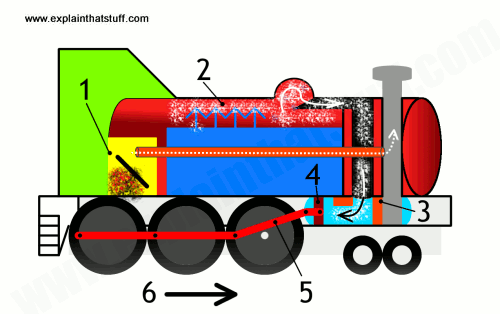How a steam engine works
Crudely speaking, there are four different parts in a steam engine:
A fire where the coal burns.
A boiler full of water that the fire heats up to make steam.
A cylinder and piston, rather like a bicycle pump but much bigger. Steam from the boiler is piped into the cylinder, causing the piston to move first one way then the other. This in and out movement (which is also known as "reciprocating") is used to drive...
A machine attached to the piston. That could be anything from a water pump to a factory machine... or even a giant steam locomotive running up and down a railroad.
That's a very simplified description, of course. In reality, there are hundreds or perhaps even thousands of parts in even the smallest locomotive.
Step-by-step

It's easiest to see how everything works in our little animation of a steam locomotive, below. Inside the locomotive cab, you load coal into the firebox (1), which is quite literally a metal box containing a roaring coal fire. The fire heats up the boiler—the "giant kettle" inside the locomotive.
Animated cutaway showing the key parts of a steam engine and how they work
The boiler (2) in a steam locomotive doesn't look much like a kettle you'd use to make a cup of tea, but it works the same way, producing steam under high pressure. The boiler is a big tank of water with dozens of thin metal tubes running through it (for simplicity, we show only one here, colored orange). The tubes run from the firebox to the chimney, carrying the heat and the smoke of the fire with them (shown as white dots inside the tube). This arrangement of boiler tubes, as they are called, means the engine's fire can heat the water in the boiler tank much faster, so it produces steam more quickly and efficiently. The water that makes the steam either comes from tanks mounted on the side of the locomotive or from a separate wagon called a tender, pulled behind the locomotive. (The tender also carries the locomotive's supply of coal.)
The steam generated in the boiler flows down into a cylinder (3) just ahead of the wheels, pushing a tight-fitting plunger, the piston (4), back and forth. A little mechanical gate in the cylinder, known as an inlet valve (shown in orange) lets the steam in. The piston is connected to one or more of the locomotive's wheels through a kind of arm-elbow-shoulder joint called a crank and connecting rod (5).
As the piston pushes, the crank and connecting rod turn the locomotive's wheels and power the train along (6). When the piston has reached the end of the cylinder, it can push no further. The train's momentum (tendency to keep moving) carries the crank onwards, pushing the piston back into the cylinder the way it came. The steam inlet valve closes. An outlet valve opens and the piston pushes the steam back through the cylinder and out up the locomotive's chimney (7). The intermittent chuff-chuff noise that a steam engine makes, and its intermittent puffs of smoke, happen when the piston moves back and forth in the cylinder.
There's a cylinder on each side of the locomotive and the two cylinders fire slightly out of step with one another to ensure there's always some power pushing the engine along.